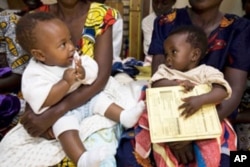For more than a year now, Rwanda has been immunizing its children against pneumonia. Its goal is to save the lives of 6,000 kids every year. This week, health officials and others are checking on the program’s progress.
Pneumonia is the leading killer of children under age five worldwide. Over one and a half million die every year from the disease, mostly in developing countries.
Rwanda takes the lead
In April 2009, Rwanda, with help from the GAVI Alliance and other partners, started a vaccination program against pneumococcal disease.
Alex Palacios, GAVI’s special representative, says, “Rwanda itself has ensured, first of all, that public health is a top priority. I think that that is a commitment and a decision made at the highest levels. And it has maintained that special priority over the years. It also happens to be a country which just about a year ago introduced the first pneumococcal vaccine in Africa.”
Palacios says the two top killers of kids can be prevented with modern medicine.
“If you consider that the combination of pneumonia, mostly from pneumococcal disease, and diarrhea, generally the result of rotavirus infection, are the major causes of child mortality - you’re looking at globally about 8.8 million children dying each year from often preventable disease. And about 40 percent of those are dying from just two causes: pneumonia and diarrhea,” he says.
Pneumococcal disease is also a major cause of bacterial meningitis, which is often fatal.
Millions could be saved
Malaria used to be the top killer of children in Rwanda. But a campaign against the disease has seen at least a 27 percent decline in children suffering from malaria.
Palacios says great success can also be made against pneumonia and diarrhea.
“The good news is that when GAVI was first created in 2000 we didn’t have those two particular vaccines against a form of pneumonia and rotavirus. Today we do. So we have the opportunity, over the next 5 years or so, in particular if you’re thinking about the Millennium Development Goal of reduction of child mortality by two-thirds, to make a very major contribution to achievement of that goal and save many lives,” he says.
He says the lives of well over four million children could be saved over the next five years.
Currently, immunization against pneumococcal disease is only in its early stages in Africa, with Rwanda at the forefront. But that’s about to change.
“Over the next four or five years, we will see 47 countries, based on their own expressions of interest in applications for support, introducing the pneumococcal vaccine and actually over 40 countries introducing the rotavirus vaccine,” he says.
Palacios adds immunization has the power to bring dramatic improvements in health in a relatively short time.
“It’s not easy to do that across all of development or across all of health, but immunization luckily has that capacity,” he says.
The GAVI Alliance special representative says an “enormous opportunity” exists to improve health. But to do that takes money. Palacios says to save the lives of millions of children over the next five years will cost $2.6 billion in additional funds. It’s a serious “resource challenge,” he says, but one that can be overcome.








